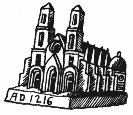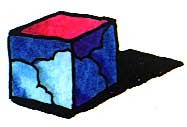| |
| |
|
|
I'm sure I know why and what I paint. It's something like a feeling of warmness in your head; a half-ready answer is waiting. But when I must put it down, my God, it's not so easy. From the very beginning, from childhood, something was wrong with me (oversensitivity, the family physician stated). Books and reading interested me first. As far as I can remember drawing was somehow regarded as natural, not respected at all -- like eating or playing with toys. My parents' house was overwhelmed by books and discussions during those dark, Stalin years. Little groups of friends gathered over the bridge table, not so much to play but mostly to talk. Up to the last moment before entering higher education, I was unsure what to choose -- philology at the university of fine arts at the academy. But the "oldies" decided to push me toward some "practical" career -- architecture, engineering. And that was the beginning of my way to the current painting. Nothing fitted me properly, the frustrations built up; now I understand it was very positive this manytimes-forced way. Disillusioned by technical training in architecture, I began desperately to add something more to this boring existence. The relatively lively cultural life of city students lured me quickly. Jazz, "nightlife," cabarets, theater -- I lived for it, waiting nervously every day at the drawing rooms of school. Troubles built; I hardly managed to pass all the exams. Finally, after two years, without resigning from my engineering school, I joined the Fine Arts Academy, trying to cope with two problems. But my "off-duty" activity didn't cease; it grew. Although extremely hectic, it was a far more exciting life. The next event, which shaped my entire life, was not designed by me but by the "Reds." Nineteen sixty-eight; student riots, Zionists, Revolutionists, tanks rumbling down Prague streets. It was a time of extreme tensions and simple "yes" or "no." After the amnesty was granted by the government to all (almost all) unruly students, I tried to rebuild. But amnesty was mainly on paper. Practically, I was eliminated. However, some brave people fought back, and by 1969 I had carefully constructed, multi-media study program, which protected me from being pushed out of the schools but gave me a mad schedule. Staying at the architecture faculty, I studied mostly design, while I worked also at the history of art institute as a junior researcher in my free time, restoring churches, etc. To keep "them" happy, I worked around the clock. My "post-school" activities had grown serious. By the early 1970s, I was among those who had rejected the "Socialist way" and tried to pursue "free culture" (read: "counter-Red establishment"). My real companions were theater, poetry, cabaret, the visual arts -- and I did anything that was needed. Thank God, it paid well, not in money but in far more important bonuses: I traveled abroad, all over Western Europe. You don't understand how hungry somebody can be to see the normal, civilized life of the Western world. During this time, I worked on those hard-to-formulate, private tensions -- my private world. Now, how do I say what I paint? Maybe it sounds megalomanical, but I try to discuss the world I see and feel. I try to care about the composition, shape, color, the so-called "form," of course. I try to execute paintings in the best possible way -- no easy tricks, no airbrushes, no copying from slides -- all hand, pure hand. But, most importantly, I try to communicate with all, concerned and unconcerned. I have no idea which trend of art I represent. Nothing interests me less. Of course, I'm sensitive to many currents of modern art, but I try to understand art as a whole. I love Old Masters but try to put their work into a larger context, not to separate their canvases from literature, music, society. I listen to music during my work. I read. I try to know a little of everything. They did the same, I think. You cannot close yourself in a personal shell. Or maybe you can. I can't. (Adapted from an interview published in Arts Magazine (New York), May 1983.)
Since my last entry in the publication, in 1990, dramatic changes occurred in my life and work. Once a leading artist of the Polish Poster school, today I do very little graphic design. In the 1980s I established myself in the galleries of New York City as a painter and printmaker. The 1990s further reinforced my position as an installation artist, only sporadically active as a graphic designer. Starting in 1990 I have had a series of museum shows of my works all over the world. I started to develop two new and important new venues in my work: sculpture and multimedia experiments. It all started with the 1989 concert sets for the Grateful Dead. From there I went to the new hand highly experimental projects. The art created directly by me, on canvas or paper, is being transformed to the kinetic images projected on screens or directly on the walls by computer synchronized projectors supported by light and original pieces of art. I designed the series of concepts for such theatrical or music pieces with the entire "visual space" created by me. The concept for Handel's Messiah was followed by my production of the Visual Theater spectacle at the Art Tower Mito, in Mito, Japan, in 1993. It was the first time I collaborated with California-based projections and light designer Marc I. Rosenthal, with whom I am working on almost all new projects of such nature. After the first successful production I designed projection-based concert sets for Steve Winwood and Traffic in 1994. Later that year I went to Tokyo to concentrate on the development of sculptures, multimedia works, and projects for architecture. I was awarded a special grant by the Japanese Cultural Agency to stay in Tokyo and experiment. The results were fantastic! I was teamed with the best architects, designers, and electronic engineers Japan has today. The series of large sculptures emerged in concepts which will soon be realized, but the most important project born in Tokyo was the Tower of Light. The giant monument as well as the live screen for kinetic images was prepared for presentation to the ruler of the United Arab Emirates. In designing and preparing the proposal for the tower I got formidable help from leading Japanese corporations like Sumitomo and Nippon Glass besides the architectural offices and planners. Sometimes I must pinch myself when flying to Tokyo or Abu Dhabi again... It feels like a magic trip for an artist who began his career as an underground graphic artist in Krakow, Poland. Years ago, when my father was pushing me to study architecture before turning to painting, I hated him. But he insisted, saying: "The true artists must know architecture -- it could come in handy one day, you never know." God bless my father. To put it the simplest way, I see design, architecture, and art as one potent mixture of ideas, rules, and challenges. Not only to create new space and color and images for people, but also to use this magic mix to work with the musicians, actors, writers, dancers, and all creative types on building THE CULTURE, regardless of religions, borders, systems...
Contemporary Artists - Fourth Edition
|
|
All artworks/images copyright Jan Sawka |
|
www.jansawka.com |







